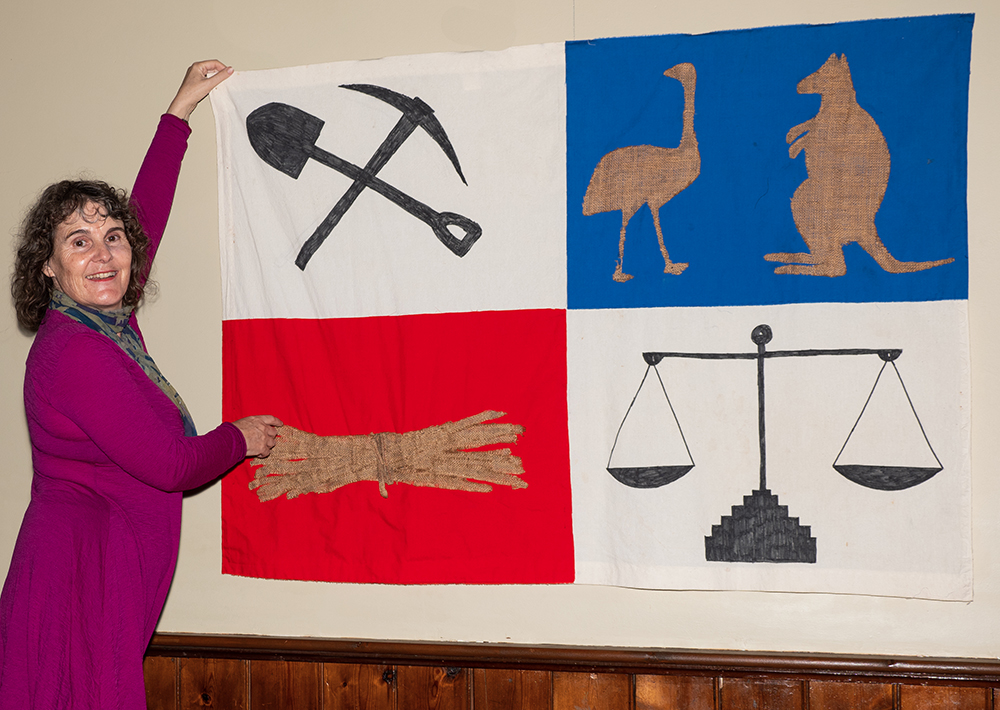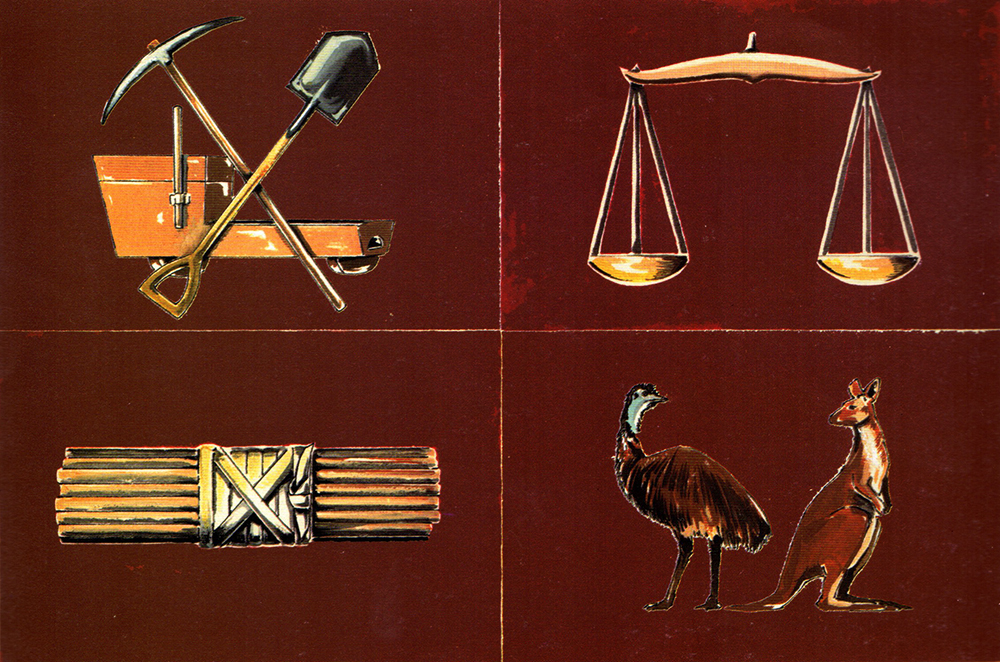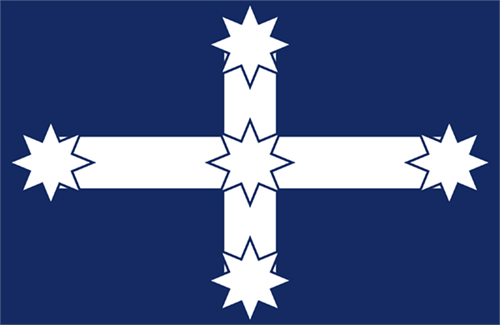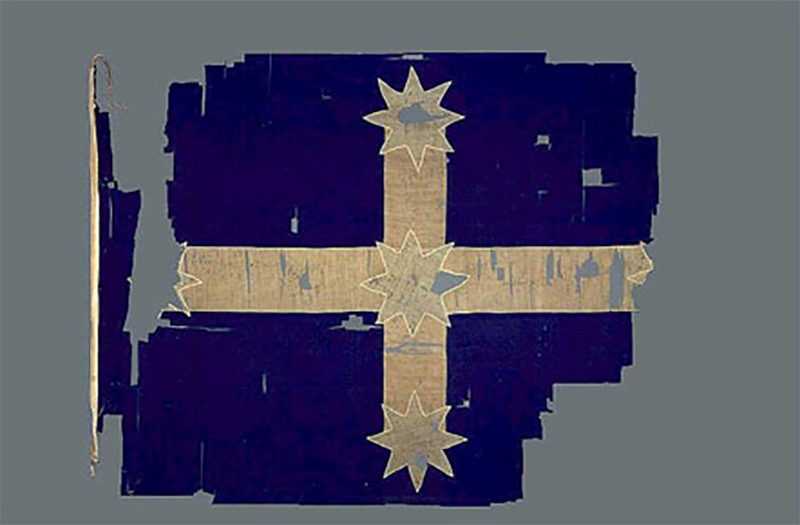THE PROTEST FLAGS OF THE 1850s VICTORIAN GOLD RUSH
The gold diggers on the Victorian goldfields in the early 1850s flew many flags and banners. Some were flown to celebrate their nationality, others to advertise their wares, such as at a general store. Others were flown to show their support for a cause, such as the anti-transportation movement. Most are now lost and forgotten.
There are three flags that are still remembered. They were created and flown at the diggers’ three major protests to show their opposition to the colonial government gold licence system. The first was flown by the Diggers in December 1851 at their Monster Meeting at Forest Creek. Then the Diggers of the Red Ribbon Movement flew their new banner at Bendigo in August 1853 and a year later the Eureka flag was flown above the Eureka Stockade at Ballarat in December 1854. The Eureka flag is a well known national icon. But the two flags of the earlier protests that led up to Eureka are not so well known.
The Red Ribbon and Eureka flags we fly today are the same design as those the Diggers flew at their 1853 and 1854 protests. Sadly the original 1851 Diggers’ Monster Meeting flag has not survived. So in 1995 it was recreated by Robyn Annear as an interpretation of the Diggers’ flag based on what can be seen in David Tulloch’s on-the-spot drawing of the 1851 Meeting and what was known about the Central Victorian goldfields of the time. Like the later Red Ribbon Banner, it shows the crossed pick and shovel representing the gold diggers’ labour, the kangaroo and emu for Australia, a tied bundle of sticks representing the diggers’ solidarity and a set of scales representing the social justice they sought.
The 15,000 gold diggers flew a new flag when they gathered for the first mass protest against the gold licence system meeting at Forest Creek on Monday 15 December 1851. We don’t know lot about that original flag. The only visual record is in a drawing of the Meeting done by David Tulloch and it shows only part of the flag. We have no record of who designed the flag, who made it or what happened to it.

The contemporary Diggers’ Flag was created in 1995 by Robin Annear for the first modern commemoration of the 1851 Meeting, as an artistic interpretation based on the Tulloch drawing and other historical sources. It now flies permanently at the site of the 1851 Meeting in the Castlemaine Diggings National Heritage Park in Dja Dja Wurrung country. The site is listed in the Victorian Heritage Register (VHR2368) to acknowledge the historical significance of the Diggers’ Meeting in the early development of democracy in Victoria.
Chewton Domain Society member, Jackie McMaster, explains how the contemporary flag was created and why it has been adopted to represent the spirit of Chewton.
The Diggers’ Monster Meeting Flag flies at various places in Chewton and Castlemaine. People have asked if this is the original historic flag design or a more recent design that Chewton has adopted. The answer is that the contemporary Diggers’ Flag is an artistic interpretation and recreation of the flag flown at the December 1851 Monster Meeting of 15,000 Diggers, when they defied the government by refusing to pay more for their gold licences. It is based on an 1852 engraving by Thomas Ham of an 1851 drawing by David Tulloch entitled The Great Meeting of Diggers 1851, plus what was known and recorded about the Central Victorian goldfields in 1851, including a report by historian William Howitt in his 1855 book , Land, Labour and Gold. The colours were based on descriptions of the clothing worn by the diggers at the time.
In 1995 Castlemaine author and historian Robyn Annear created a hand drawn and stitched recreation of the original flag for the first commemoration of the 1851 Meeting. It was her best interpretation using the information. She explained that the design came from looking at the Tulloch/Ham lithograph and reading historian Howitt’s report (in his 1855 book Land Labour and Gold) that an earlier version of the Red Ribbon Rebellion flag had been flown at the Monster Meeting in 1851.
In 1999 editor Phil Ingamels, commissioned artist Robert Avitabile to refine Robyn’s flag design to be included in the book Discovering the Mount Alexander Diggings published by Friends of the Castlemaine Diggings (FOMAD).
Tulloch’s drawing shows the flag had four quadrants with a pick and shovel in the top left hand quadrant. Because the flag is drawn fluttering the other symbols are not clearly visible. Robyn’s contemporary design has four quadrants like the original, with the following four symbols.
- the pick and shovel (for the diggers’ labour),
- a set of scales (for the social justice they sought),
- a tied bundle of sticks (representing the strength of their unity) and
- kangaroo and emu (for Australia).

In the early 2000s a group of history enthusiasts began publicising the 1851 Monster Meeting under the auspices of the Chewton Domain Society. The Society set about trying to unearth some more detailed information about what the flag had looked like, with a view to getting some replica flags made. Letters published in local papers and a query in the Weekly Times about the flag design and colours brought no responses. Because the Monster Meeting was considered an important event in the birth of democracy in our country, the group itself was democratic in the process of deciding exactly how Chewton’s Diggers’ Flag should look. They used a worksheet so that any interested party could say how they thought the flag should be interpreted. Eventually it was voted that the flag design in the FOMAD book was an excellent, thoughtful and educated interpretation of the historical flag. So permission was sought and given to use that design.
The flag we fly now is the result of that collaborative team effort to research and finalise the design with input from many people. It has been flown since then to remind people of the how the Diggers of 1851 at their Monster Meeting set in motion a democratic movement of protest that was a first step in the development of democracy in Victoria. It has also been adopted as representing the spirit of Chewton – taking a stand together to fight for our rights and social justice. For example, the flag was flown over the Chewton Pool in 2009 when the community was battling to save it from being closed.
However not everyone agrees that the design of the contemporary flag is appropriate. Goldfields author and artist, Geoff Hocking, believes that the flag adopted by the Chewton Domain Society, with its bold colours and graphic symbols, is too contemporary to be historically accurate. His alternative view can be read in full in the Bendigo Magazine Spring 2006 (www.bendigomagazine.com.au). Geoff suggests that a contemporary interpretation of the flag should better reflect what we know of the history of the very different decorative styles, technique and imagery at the the time.
But Geoff concludes:
Any interpretation of our history is a tricky business. When Bendigo and Chewton look to tell their story of their part in the story of the gold fields agitation, from the Great Meeting to the Red Ribbon Rebellion, they need a banner as bright, and as thoughtful in the interpretation of its meaning as that flown in another large central goldfields city. And they need to fly them from the highest flagpoles, after all the Bendigo and Chewton agitations were bigger, better armed and better organised than that other one in 1854 – just no one got shot.

The illustration, by Castlemaine artist Rhyll Plant, is based on William Howitt’s description of the flag in Land, Labour & Gold (published 1855). Graphic reprinted from Geoff Hockings book, The Red Ribbon Rebellion! p23.
In August 1853 the Red Ribbon Banner was carried in procession by thousands of protesting gold miners from across the Bendigo field demanding that the colonial government reduce the cost of their gold licences. The Geelong Advertiser reported the flag carried in the march:
“Gully after gully hoisted its own flag, around which the various sections rallied, and as they proceeded towards the starting points, formed quite an animated spectacle … But the flag which attracted the greatest attention was the Diggers’ Banner, the work of one of the Committee, Mr Dexter, an artist of considerable talent, and certainly no company ever possessed a more appropriate coat of arms, or a motto more in character with themselves.”
The flag designed by Mr Dexter, a Bendigo gold miner and china painter, has four quadrants with the following symbols, similar to the 1851 Monster Meeting flag:
- pick, shovel and cradle (representing the manual labour of the gold diggers),
- a tied bundle of sticks (representing the need for unity/solidarity)
- the scales of justice (representing the social justice they sought) and
- the kangaroo & emu (for Australia).
The Bendigo Diggers of the Red Ribbon Movement established the Anti-Gold-Licence Association and organised the Bendigo Petition, that gathered thousands of signatures, demanding that Governor La Trobe reduce the licence fee to 10 shillings, make it available on a quarterly basis and stop the troopers’ violent enforcement of the licence tax. The original long silk bound Bendigo Petition is held and may be viewed at the Victorian State Library in Melbourne. They also demanded access to land.
When La Trobe dismissed their demands, the Red Ribbon Rebellion was born and 10,000 Diggers, many armed, marched with their new banner to the Gold Commissioner’s camp to declare their grievances and their determination to pay only 10 shillings for their licences. They surrounded the camp and formally offered Commissioner Panton ten shillings for a licence. He refused to accept it but agreed to take their demands to Governor La Trobe and the stand-off ended without any shots fired. But the Diggers had made their point and in the next month only 400 diggers paid their licence fee, compared with thousands the month before.
The Diggers’ stand-off forced La Trobe’s hand. He suspended the licence system and established a Committee of Inquiry which proposed a lower scale of fees, voting rights for diggers with annual licences and access to allotments of land. La Trobe also commenced the delayed drafting of the new Constitution for Victoria, which was passed by the Victorian Legislative Council in March 1854, and sent to Britain for royal assent eight months before the uprising at the Eureka Stockade in December. The new Constitution, with the royal signature attached, was returned to Victoria and finally proclaimed in November 1855.
For more information about the Red Ribbon Rebellion, the Bendigo Petition and their banner, read The Red Ribbon Rebellion! by Geoff Hocking, Bendigo. A History by Frank Cusack (Chap 10 & 11) and Mount Alexander Mountain of Gold 1851 – 1861: The gold rush generation and the new society by Marjorie Theobald (Chap 2).
The flag that flew over the Eureka Stockade in December 1854 represents the Southern Cross in the night sky. It was first flown in Ballarat on Bakery Hill on 29 November 1854 when thousands of miners gathered to protest against the colonial government. The miners gathered around the flag and swore ’by the Southern Cross to stand truly by each other, and fight to defend our rights and liberties’. The flag then flew above the Eureka Stockade until it was torn down by government troopers who attacked at dawn on Sunday 3 December 1854.

The Eureka Flag was damaged, lost and stored away in a cupboard for many years but it has now been restored and is displayed at the Eureka Centre in Ballarat. It is listed as an object of State heritage significance in the Victorian Heritage Register and was designated as a Victorian Icon by the National Trust in 2006.

For information about the Eureka Rebellion and the Eureka flag go to the website of the Ballarat Reform League at ballaratreformleague.org.au, the Eureka Centre at eurekacentreballarat.com.au and read Len Fox’s book, Eureka and its Flag and go to https://en.wikipedia.org/wiki/Eureka Flag.
People have questioned whether there was an iconic Diggers’ protest flag which appeared first at the Forest Creek Monster Meeting of 15 December 1851 and was subsequently adopted on the other fields. Based on research done with the late Doug Ralph, Marjorie Theobald examines and questions this idea. (click here to read)
